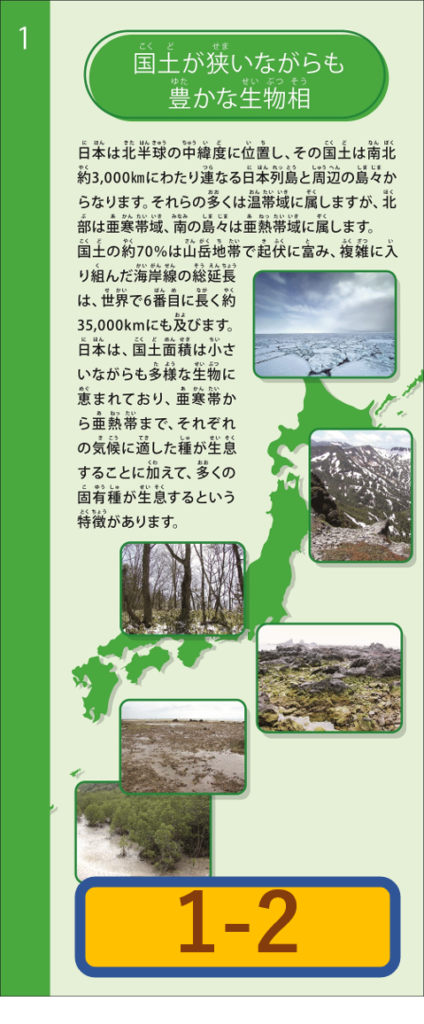1. Biodiversity in Japan

1-1 What is Biodiversity?
Various species live on the earth (Diversity of Species).
Many organisms live in various environments, interacting with each other to create diverse ecosystems (Diversity of Ecosystems ).
Even among the same species, each individual may have different genes (Genetic Diversity).
“Biodiversity” is the term to express the different ways various living things present.
Many organisms coexist.
There are various patterns even within the same species.

1-2 A rich biota, even in a small area.
Japan is located in the northern hemisphere in the mid-latitude range and is comprised of the Japanese archipelago and surrounding islands, stretching approximately 3,000 km from north to south. Most of this area is classified as temperate zones, but the northern area is in the subarctic zone and the southern islands are in the subtropical zone.
70% of land is mountainous and rugged, while the total length of intricate coastline is approximately 35,000km, the 6th longest in the world.
Although the land area of Japan is small, it is blessed with a diverse range of living organisms. Not only home to species each suited to a specific climate, from subarctic to subtropical, the area is also characterized by a large number of endemic species.

1-3 Imminent crisis for many endemic species
Species found in their natural condition only in Japan are called “endemic species to Japan.” Japan is referred to as “biodiversity hot spot,” for its particularly abundant endemic species, even on the global scale. However, the existence of these endemic species cannot be considered secure. On the Ogasawara Islands, known as the area with the richest endemic species in Japan, human activities have caused the extinction of 1 mammalian, 6 avian, 19 land snail and 2 plant species. Like many species on the Ogasawara Islands, since most endemic species in Japan are distributed only in a small area, many are threatened.
▼Bonin wood pigeon, an endemic species which once lived on the Ogasawara Islands.

1-4 Topographic Map of Biodiversity
Topographic maps of biodiversity are a three-dimensional representation of the diverse organisms which live in a region. By molding the distribution data of various species three-dimensionally, how biodiversity is spread out over a region can be easily understood. In order to better understand biodiversity in Japan, The National Museum of Nature and Science has worked to compile a database of many specimens in our collection and organize them into topographic maps of biodiversity.